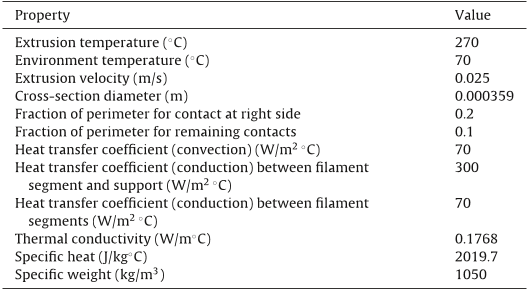Estimation of filament temperature and adhesion development in fused deposition techniques
TLDR
In this paper, an analytical solution to the transient heat conduction developing during filament deposition in Fused Deposition Techniques (FDT), which is coupled to a routine that activates or deactivates all relevant local boundary conditions depending on part geometry, operating conditions and deposition strategy, is presented.About:
This article is published in Journal of Materials Processing Technology.The article was published on 2017-07-01 and is currently open access. It has received 180 citations till now. The article focuses on the topics: Protein filament & Deposition (phase transition).read more
Figures

Table 1 Process parameters and material properties. 
Table 2 Material properties of ABS FA 4475. 
Fig. 5. Geometry and deposition sequence used to illustrate the results of the calculations (dimensions in mm). 
Fig. 6 shows the filament temperature at various instants of he deposition process (an animated view of cooling can be creted). Clearly, the newest filament segment or elementary length s always the hottest one and cools down gradually, although the ffect of the physical contacts is difficult to perceive in this repreentation. The phenomenon is better seen in Fig. 7, which depicts he time evolution of the temperature of filament segments 1–9 t a vertical xx plan distant 0.05 m from the origin (see Fig. 5). As a ew filament segment is deposited, the temperature of the adjacent egments increases and so their cooling is delayed. The physical ontacts can alter local filament temperatures by as much as 18 ◦C. 
Fig. 15. Temperature evolution with time (at x = 40 mm) of a filament segment deposited on top of another (die set to 200 ◦C and 220 ◦C). 
Fig. 7. Time evolution of the temperature of filament segments 1–9 for the geometry and deposition sequence illustrated in Fig. 5, at a vertical xx plan distant 0.05 m from the origin.
Citations
More filters
Journal ArticleDOI
Numerical investigation of the influence of process conditions on the temperature variation in fused deposition modeling
TL;DR: In this article, an adaptable three-dimensional transient mathematical model of temperature variation with respect to space and time, during and after the fused deposition modeling (FDM), is proposed and applied with a boundary-adjusting finite difference method.
Journal ArticleDOI
Experimental validation of a numerical model for the strand shape in material extrusion additive manufacturing
TL;DR: In this article, the influence of the processing conditions on the cross-section of a strand printed by material extrusion additive manufacturing is investigated experimentally and numerically, using optical microscopy.
Journal ArticleDOI
Biodegradable Polymers for Biomedical Additive Manufacturing
Dario Puppi,Federica Chiellini +1 more
TL;DR: An update overview of scientific literature on biodegradable polymers for AM application in the biomedical field is provided, highlighting their source of extraction, chemical modification, or synthesis route, and their physical-chemical and processing properties in relationship to AM.
Journal ArticleDOI
Roadmap to 3D-Printed Oral Pharmaceutical Dosage Forms: Feedstock Filament Properties and Characterization for Fused Deposition Modeling.
TL;DR: This commentary reviews recent 3D-printing studies by fused deposition modeling (FDM) technique in pharmaceutical sciences, extending into the fields of polymer processing and rapid prototyping, where more in-depth studies on the feedstock material properties, modeling, and simulation of the FDM process have been performed.
Journal ArticleDOI
Polypropylene Filled With Glass Spheres in Extrusion-Based Additive Manufacturing: Effect of Filler Size and Printing Chamber Temperature
Martin Spoerk,Florian Arbeiter,Ivan Raguž,Georg Weingrill,Thomas Fischinger,Gerhard Traxler,Stephan Schuschnigg,Ludwig Cardon,Clemens Holzer +8 more
TL;DR: In this paper, the incorporation of low aspect ratio fillers improved this issue by successfully decreasing the warpage of 3D-printed polypropylene (PP) parts, which is a promising material for FFF due to its high impact strength, chemical resistance, moisture stability, and low cost.
References
More filters
Journal ArticleDOI
Anisotropic material properties of fused deposition modeling ABS
TL;DR: In this article, the properties of FDM parts fabricated by the FDM 1650 were analyzed using a Design of Experiment (DOE) approach, such as raster orientation, air gap, bead width, color and model temperature.
Journal ArticleDOI
Parametric appraisal of mechanical property of fused deposition modelling processed parts
TL;DR: In this paper, five important process parameters such as layer thickness, orientation, raster angle, Raster width and air gap are considered and their influence on three responses such as tensile, flexural and impact strength of test specimen is studied.
Journal ArticleDOI
Effect of processing conditions on the bonding quality of FDM polymer filaments
TL;DR: In this article, the authors investigated the mechanisms controlling the bond formation among extruded polymer filaments in the fused deposition modeling (FDM) process and showed that the bonding phenomenon is thermally driven and ultimately determines the integrity and mechanical properties of the resultant prototypes.
Book
Rapid Prototyping: Principles and Applications
TL;DR: In this paper, the authors present animated illustrations of the working principles of today's key Rapid prototyping processes, the available models and specifications, and their principles, materials, advantages and disadvantages.